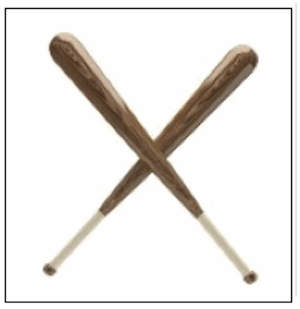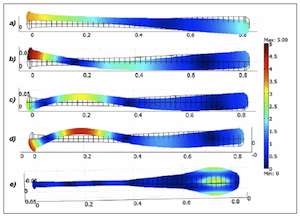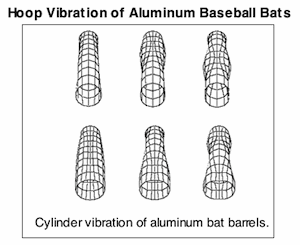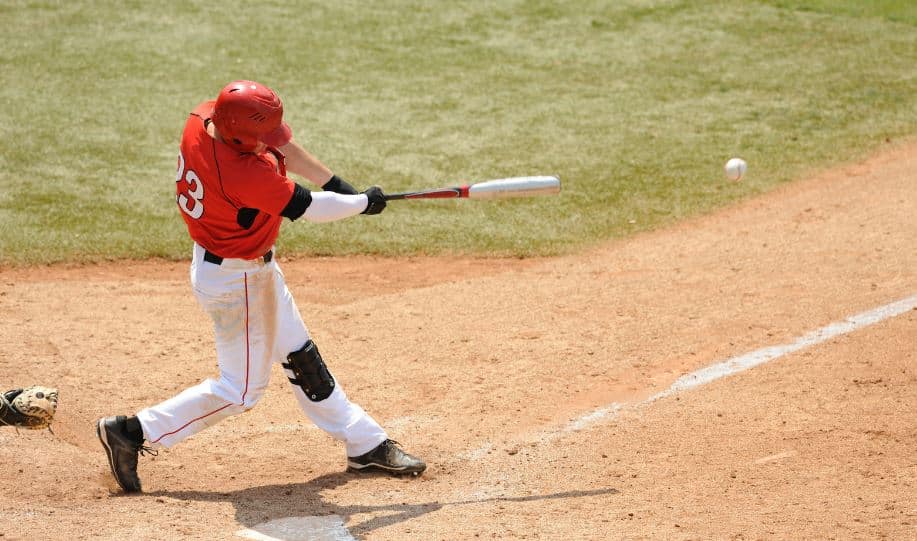Implications of the Sound of the Baseball Bat When Striking a Ball
A hollow aluminum bat sounds much different from a solid wood bat because the walls can vibrate. The sound is typically between 1000 and 2500 Hz, meaning that is essentially the frequency with which the walls vibrate. Much of this stored elastic energy is retained as vibration energy in the bat. If it is less than 1000 Hz, the result is that the ball comes off the bat at a lower speed than off a wood bat of the same weight and swing weight. It is for this reason that walls of hollow bats are designed to vibrate at a frequency greater than 1000 Hz.
A solid wood bat will vibrate only with bending motion (Figures 1a,b,c,d – from Gibbens et. al.). A hollow aluminum or composite bat, on the other hand (Figure 1e), is able to exhibit both bending modes and another class of vibrational shapes referred to as hoop modes. Hoop modes are unique to hollow cylinders and involve alternate compression and expansion of the barrel of the bat (Figure 2). The fundamental hoop mode is responsible for both the “ping” sound of a metal bat, and also for the so-call “trampoline effect” (the ball bounces off metal better than it bounces off wood).
The same trampoline effect occurs with tennis racquets, except that with tennis racquets the strings are very light and return to the ball about 95% of their stored elastic energy. The wall of an aluminum baseball bat is relatively heavy and returns a much smaller amount of its stored elastic energy to the ball, keeping the rest to itself, allowing it to ping as loudly as it wants.

Figure 1: Modes of bat vibration generated by COMSOL software showing relative displacement.
a) the initial 0 Hz mode of the ash bat, b) the first mode of the ash bat, c) second order mode
of transverse vibration in the ash bat, d) second order mode of a corked ash bat, e) fundamental
hoop mode of an aluminum bat.
The “ping” mode of the cylinder is responsible for the so-called “trampoline effect” of metal bats, which allows them to propel a ball with greater speed, and hence, farther, than from a wood bat. In wood bats, a hit away from the sweet spot results in bat vibrations that consume energy that should have gone to the ball. As a result, the ball does not go as far. However, with an aluminum bat, a hit away from the sweet spot, the bending vibrations take energy away from the ball, but the cylinder vibrations return energy to the ball. This returned energy can sometimes be greater than the energy lost to the bending vibrations. This is a reason why balls hit with an aluminum bat usually travel farther than balls hit with a wood bat – especially for hits not at the sweet spot. On the other hand, wooden bats have a smaller “sweet spot” where the vibration impact cannot be as easily felt by the hands because of the weight and density of the wood.

Figure 2. Hoop vibration of aluminum baseball bats showing the modes of compression and expansion along the barrel of the bat.
Acoustic Theory/Limitations
Because aluminum baseball bats have irregular longitudinal shapes, non-uniform cross sections, walls of varying thickness, unspecified materials alloyed with the aluminum, and various types of filler material in the center, no known accurate acoustic models exist for aluminum baseball bats. However, the acoustic theory for metal bars and cylinders can provide some insight into the resonance sounds produced when a bat strikes an object, and therefore, this is often used, especially when identifying the fundamental frequency and its harmonics – both odd and even harmonics.
Is the Sound of the Hit Useful to Players?
Tennis players (as well as players of other sports where objects collide) can determine the type of ball to expect based on the sound made when the racket hits the ball. Baseball players make similar comments, especially when speaking about wood bats. Due to different frequencies, the sound of the bat hitting the ball differs depending on where the bat makes contact with the ball.
Outfielders say they use the sound to quickly estimate which direction they should run. If the crack has a high-frequency sound, the outfielder knows to run back towards the fence. If a low-frequency sound, a “thud or thump,” is heard, the outfielder knows to run in somewhat.
Although changes have altered the sport throughout the years, the foundation upon which baseball was built still remains the same. That foundation is the classic conflict between the pitcher and batter. And, the batter’s weapon does make a difference.
References:
Gibbens, M, Kaiser, S, Youngblood, N. Who’s on first, Consortium for Mathematics and Its Applications’ Mathematical Contest in Modeling 1010 Competition, Meritorious Winner, February 22, 2010
Adair, R.K. The Physics of Baseball, 2nd ed., Perennial-Harper Collins Publisher, Inc., New York, 1994, pp. 108-138 1994
Van Zandt, L. L the dynamical theory of the baseball bat, American Journal of Physics, 60(2), 172-181, 1992
Russell, D.A., Physics and acoustics of baseball & softball bats, http://www.acs.psu.edu/drussell/bats/crack-ping.html
Wayne Staab, PhD, is an internationally recognized authority in hearing aids. As President of Dr. Wayne J. Staab and Associates, he is engaged in consulting, research, development, manufacturing, education, and marketing projects related to hearing. His professional career has included University teaching, hearing clinic work, hearing aid company management and sales, and extensive work with engineering in developing and bringing new technology and products to the discipline of hearing. This varied background allows him to couple manufacturing and business with the science of acoustics to bring innovative developments and insights to our discipline. Dr. Staab has authored numerous books, chapters, and articles related to hearing aids and their fitting, and is an internationally-requested presenter. He is a past President and past Executive Director of the American Auditory Society and a retired Fellow of the International Collegium of Rehabilitative Audiology.
**this piece has been updated for clarity. It originally published on August 19, 2013








I used to serve as Director of Audiology for the World Games for the Deaf (now known as Deaflympics). To complete in the Deaflympics, athletes must have at least a 56 dB loss in the better ear. During competition, athletes are not allowed to wear their hearing aids or implants. This rule was used level the playing field between hard of hearing and deaf athletes by removing acoustic cues created by balls hitting rackets, bats, hockey sticks or hands/heads (soccer and volleyball). I never thought this rule was fair as many hard of hearing people learn sports the way normal hearing people do – via the integration of auditory and visual (and other) cues. On the other hand, a deaf athlete (who has never worn hearing enhancement technology) has learned his/her sport using visual (and other) cues with the except of those that are auditory. I am aware of research on visual and auditory integration in sport performance, but have never seen a study that answers the question: “If you take two competing athletes who play the same sport and one has learned it with no auditory cues and the other has learned it with auditory cues (that are now taken away), who wins?”